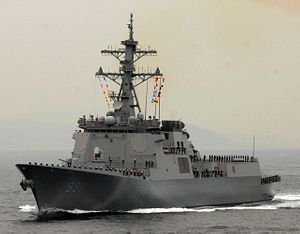South Korea is considering fitting its Sejong the Great-class guided missile destroyers with the Raytheon Standard Missile-3 ballistic missile defense system. South Korea’s Yonhap news agency reports that the United States and South Korea will begin discussing the transfer soon.
The SM-3 is part of a broader effort by South Korea to ward off ballistic missile threats from North Korea. Pyongyang is testing a variety of road-mobile ballistic missiles and one submarine-launched ballistic missile. South Korea’s existing Aegis destroyers feature the SM-2 surface-to-air missile, which, according to the U.S. Missile Defense Agency, is capable of intercepting some “short-range ballistic missiles in the terminal phase.”
Murmurs surrounding the possible adoption of the SM-3 by the Republic of Korea Navy have been circulating for some time now. Yonhap reported in May that Seoul was “moving to install new vertical missile launch systems” on its Aegis-equipped destroyers.
The SM-3 would supplement parallel missile defense efforts in South Korea. For instance, the United States is also reportedly looking to upgrade South Korea’s Patriot Advanced Capability-2 missile defense systems to the more advanced PAC-3 platforms. South Korea would become the third U.S. ally after Japan and Taiwan to field the PAC-3 system.
“Right now we’re focused on upgrading the Patriot system that we have here in Korea,” Eric Fanning, the U.S. secretary of the army, told Yonhap. “I have seen the potential for the upgrades,” Fanning reportedly added, strongly suggesting that a PAC-3 upgrade was forthcoming.
Earlier this summer, for the first time, a U.S. PAC-3 system was temporarily transferred from Kadena Air base in Okinawa, Japan, to Busan, South Korea.
Washington and Seoul recently stoked controversy both domestically within South Korea and with Beijing over their recent joint decision to deploy the Terminal High Altitude Area Defense (THAAD) system in Seongju province. China has strongly protested the decision to deploy the THAAD platform, fearing that the accompanying X-band radars would be able to convey sensitive data on Chinese missile testing and aircraft activity to the United States.
Both the SM-3 purchase and PAC-3 upgrade have yet to be formally acknowledged by the United States or receive approval under the U.S. Foreign Military Sales program.
Ballistic missile defense in Northeast Asia has taken on special importance for the U.S.-South Korea alliance in recent years amid steady advances in North Korea’s ballistic missile programs. Japan, another U.S. ally concerned about North Korea’s missile development, is also coordinating trilaterally with the United States and South Korea specifically on ballistic missile defense.
Earlier this summer, the U.S. Navy, Republic of Korea Navy, and Japanese Maritime Self-Defense Force held their first-ever joint trilateral ballistic target tracking exercise at sea on the sidelines of the 2016 Rim of the Pacific exercises.
The exercise focused primarily on improving coordination and interoperability between the three navies to assist in the detection and tracking of ballistic targets.
Last year, the United States and Japan successfully tested the next-generation Block-IIA variant of the SM-3, which is under joint development by Raytheon and Japan’s Mitsubishi Heavy Industries.
The Block-IIA SM-3 is expected to undergo interception testing later this year.

































